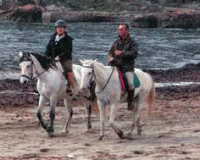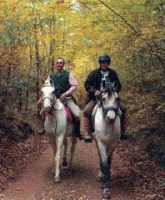Italy- Horse Trekking in Tuscany


By Judie Framan
Photos by Elliot Framan
Tuscany is one of the world's most popular travel destinations, a charmed land, blessed by nature and man. The famed English writer D. H. Lawrence said of Tuscany, It is the achieving of a particular Italian beauty which is so exquisitely natural because man, feeling his way sensitively to the fruitfulness of the earth, has molded the earth to his necessity without violating it.
My husband and I had traveled to Tuscany to experience this amazing land where the horse tradition began and is central to the lives, history, and culture of the people. Our Etruscan adventure began in Proceno, a small medieval village in southern Tuscany, near the border of Alta Lazio. We had traveled south from Florence, driving through the beautiful countryside, rolling hills coated with vineyards and surrounded by dark green cypresses. We were to experience three days of a new eight-day riding holiday that began near the medieval village of Proceno and ended at the Mediterranean Sea, a distance of 90 kilometers.
The farm of our hosts, Michele and Nicola Dolcetti, is about three kilometers past the town of Proceno. When we stepped out of the car we were greeted by the farm dogs, cats, and Nicola, whose warm smile and effervescent personality made us feel instantly welcome. Nicola and Michele, who is to be our guide for this adventure, bought the farm two years ago, and it is here that their horses stay.
Guests are lodged in one of the local Bed and Breakfast establishments, which are part of the agriturismo enterprise, popular in southern Tuscany. Nicola took us to our lodging, an apartment inside the walls of a 12th century medieval castle.
The owner of Castello de Proceno, Cecilia Cecchini Bisoni, was charming and made us feel instantly at home. She told us that the castle has been in her family since 1100 A.D., a gift from the Pope at that time. Later, Cecilia and her husband Giovanni gave us a complete tour of the castle and tower. It was like walking into a museum. Authentic Etruscan pottery and pictures of Cecilia's ancestors lined the walls along with quality museum pieces. My husband's boyhood dreams of living in a medieval castle were finally realized on this trip.
Later that evening we met Michele, a fair haired Italian full of mirth and an incredible passion for horses and history. We all went to dine at La Dogana, a 13th century carriage house on the border of Tuscany and what was then the Papal States. The three-course meal was exquisitely prepared, starting with bruschetta alla pomadora, prosciutto, fettuccine with porcini mushrooms in a white sauce, and followed by venison with spinach, all accompanied by a perfect selection of Tuscan wine. I could barely breathe by the time we got to dessert, a delicious tiramisu. This was but the beginning of four days of incredible meals presented in ways that only the Italians can create.
The next morning, we met our horses in a grassy meadow beside a bubbling stream. It was here that we began our journey through some of the loveliest parts of Tuscany. The horses were locally bred Italian warmbloods, Maremma (horses that are native to Tuscany), and Anglo-Arab crosses. I was teamed with the most perfect horse, a beautiful 16-hand gray Lippizan Arabian cross named Tebaldo, a no nonsense horse who was even-tempered and understood every cue.
It has been said that horses leave their footprints on our heart as they carry us to freedom. On Tebaldo's back, I cantered over rolling hills, across farmland and along beaches, trotted through forests, walked along age-old trails, climbed hills and gazed at some of the most magical vistas I have ever seen.
Tuscany is steeped in history. The name is derived from the Etruscans, the most powerful civilization of pre-Roman Italy. On our first day we rode through an historic private forest of Oak, Chestnut, and Beech trees, ablaze with autumn color and free of the intrusion of mankind. We traveled along an old Etruscan road that was cut into volcanic stone called tuff. In ancient times, this road linked Rome to the Mediterranean. As I walked along, I wondered how many people and horses had passed along this track before me. How did they live? What was their language like? Perhaps even the first king of Rome, who was an Etruscan, had come this way. Today the area is used for sheep breeding and the production of the famed Pecorino cheese.
Later that day, we rode to the walled medieval town of Sorano where we were to have lunch. like many medieval towns, Sorano was built over Etruscan ruins, and as we rode, we could see the open Etruscan tombs along the way. Passing through the ancient gates and clattering up cobblestone streets, like the knights of old, put us back in the middle ages. After lunch and a rest for the horses, we continued riding in the tuff area along the river Lente that snakes its way through the forest. We passed more Etruscan caves in which people still lived up until 150 years ago.
Another road led us away from the river and up a path that was carved out of the volcanic tuff. The horses picked their way carefully along the smooth black stone, a testament to their surefootedness. Walls on either side of us rose eight to ten feet, and the track was seven to ten feet wide. For the Etruscans, this was the path through the woods from their settlement that kept them safe and out of sight of their enemies.
At the top we came to the Colamhari Archaeological Park. Hundreds of caves were carved in the hillside rock; some large, some small, some connected as if for several related families. The site dates back to the 6th century B.C. We also saw the remains of other structures including row upon row of burial tombs - little niches that held terra cotta funerary urns. Over the course of their rule, the Etruscans brought many things to Italy from their travels, including artworks and the art of winemaking from Greece.
We lodged that night at an agriturismo bed and breakfast called Laconda Pantanello, located just outside Pitigliano, a medieval hilltop town so homogeneous that it appeared to be a single building. To qualify for agriturismo status, the food and animals on the farm must be raised organically, as processed and genetically engineered food is banned in Tuscany. The rust-colored farmhouse, with its stone facade, was typical of the area, and exquisitely appointed.
We took our evening meal with the family in a large living/dining area with a vast fIreplace at one end. In Tuscany, the fIreplace not only provides warmth, but is used for roasting meat and other cooking. The meal, again a many course affair, started with antipasto of crostini (garlic toast cooked in the fIreplace), piled high with tomato, grilled eggplant ana zucchini, and prosciutto. The first course was the most incredible ravioli (called tortoloni) stuffed with spinach and Ricotta cheese and smothered with a wild boar meat sauce. The main course, grilled lamb and pork chops was followed by a salad of three kinds of lettuce, radishes, and olive oil and vinegar. Of course, local wine accompanied the meal. The Tuscan finish was almond biscotti and Vin Santo di Sovana, a dessert wine made of dried grapes.
By the next day we had ridden squarely into the Maremma region of Tuscany, a coastal plain of abundant agriculture that the Etruscans, whose engineering genius in drainage and irrigation, shaped the area into one of huge agricultural potential that remains today. Trotting along a country road, we saw butteri (Tuscan cowboys) riding sturdy Maremmano horses, herding long-homed Maremmano cattle. The horsemanship skills of the butteri are legend, and for most of the year they ride with the herds on the Maremma grasslands. From time to time they make an appearance at festivals and special events, such as the one in 1911 when Buffalo Bill brought the travelling troupe of American cowboys to Rome, where they were trounced by the butteri in a series of rodeo events.
As one climbs up through the forest you see a slow change in nature from continental to evergreen forest. An old roman road leads the way to the coast. We can already smell the sea breezes from the Mediterranean. Riding along, fall colors blazed from the grapevines that marched straight as an arrow across the rolling hills, alternated with a golden sea of wheat. We stopped to talk to a farmer and his wife who were harvesting olives. Every inch of this land has been sculpted by both the elements and many generations of farmers whose purpose was to make Thscany as beautiful as possible while preserving the productivity of the land. That evening we arrived at our second agriturismo, I Poggi Etruschi Di Capalbio, near the seaside village of Capalbio. It was here that we toured the farm to look at the vast array of animals, some of them endangered species, including the Miccio Arniatino donkey and the miniature ponies.
On our final day we set off along a long stretch of beach at Ansedonia. One of the rewards of riding all the way to the coast was cantering along the sandy shore in the shadow of Etruscan caves. Tebaldo burst forth into a giant rolling canter that seemed to go on forever. We trotted back along the beach and turned on to the road that led toward Proceno, the Tuscan hills illuminated by crimson sunlight.
My husband and I have taken fabulous riding vacations before, but none was quite as unique and exciting as our four day Etruscan journey. On our last evening we erijoyed a meal in the tower of Castello de Proceno prepared by our hosts Cecilia and Giovanni. As we sat in the glow of the firelight, I was instantly grateful to Nicola and Michele for helping us discover the true heart of Tuscany.




